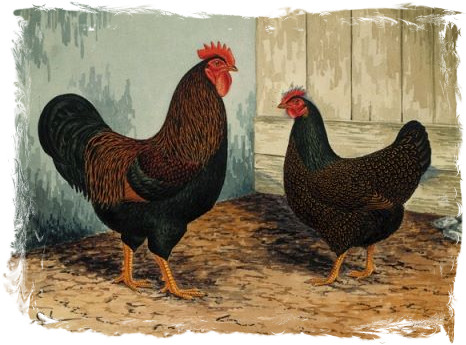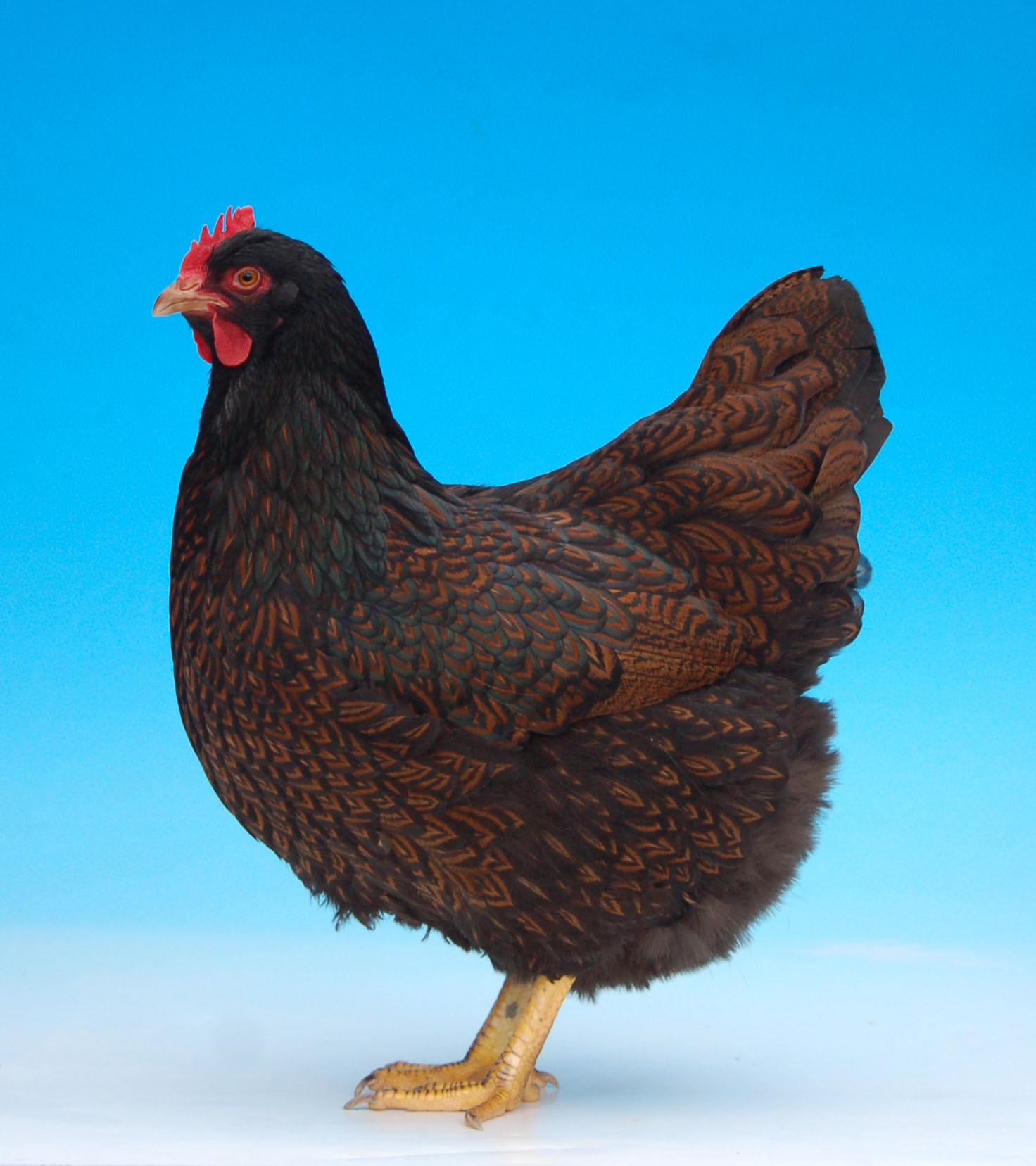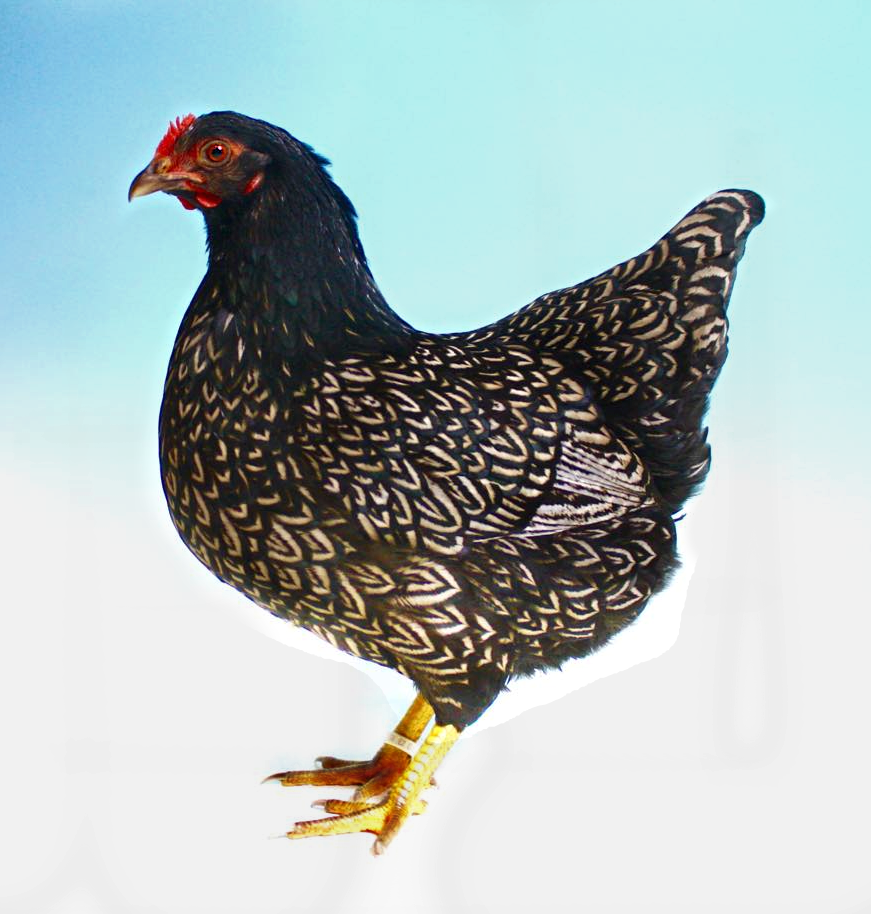Breed Standards
Up-to-date as of 2021.
Origin: The Netherlands
Classification: Heavy Soft Feather
Egg Colour: Brown
This breed was originated in the district of Barneveld, The Netherlands, and stock was imported into this country about 1921, with the brown eggs as one of the chief attractions. At first, the birds were very mixed for markings, some being double laced, others single, while the majority followed a partridge or ‘stippled’ pattern. Two varieties were standardised, namely, double laced and partridge or ‘stippled’, but the former gradually came to the top, and is the popular variety of today.
General Characteristics
Male
Carriage: Alert, upright and well balanced, the body appearing compressed, and the back concave.
Type: Body of medium length, deep and broad shoulders and high-set saddle. Breast and rump deep, broad and full. Wings rather short and carried high. Tail full, with graceful and uniform sweep.
Head: Carried high with neat skull. Beak short and full. Eyes very bold, bright and prominent. Comb single, upright, of medium size and well serrated, with a firm base, the heel to follow the neck. Face smooth and as free from feathers as possible. Ear-lobes long. Wattles of medium size.
Neck: Faily long, full and carried erect.
Legs and feet: Thighs and shanks of medium length to give symmetry. Shanks and feet free from feathers. Toes, four, well spread.
Plumage: Fairly tight and of nice texture.
Female
The general characteristics are similar to those of the male, allowing for the natural sexual differences.

Van Gink’s painting of ‘perfect’ Barnevelders.
Colour
The black
Male and female plumage: Black with beetle-green sheen.
The double laced
Male plumage: Neck and saddle hackles to match for colour and definition, each feather to be black (beetle-green) with slight red-brown edging and red-brown centre quill (stem) finishing black to tip. Breast red-brown with black (beetle-green) outer edging or lacing. Back and cape red-brown feathers with very wide black lacing. Abdomen and thighs black (beetle-green) with black down. Wing bow and bar red-brown with broad lacing; primaries, inner edge black, outer red-brown; secondaries, inner edge black, outer red-brown finely laced with black, showing when closed as a red-brown bay. Tail, all main feathers black, with beetle-green sickles and hangers. All visible black feathers and lacing to show beetle-green sheen. Undercolour dark slate.
Female plumage: Hackle black with beetle-green sheen. Breast, saddle, back, and thighs red-brown ground clear of peppering, each feather with defined glossy black outer lacing, and inner defined lacing, the outer to be distinct yet not so heavy as to give a black appearance to the bird in the show-pen. Abdomen black with black down preferred. Wing primaries inner edge black, outer brown, finely laced with black. Tail, main feathers black with laced feather well up to them. Undercolour grey.
The double laced silver
Male plumage: Plumage as in the double laced chestnut, with chestnut ground colour replaced with a silvery white. Black lacing is retained. Laced chest preferred, however a solid black chest is acceptable.
Female plumage: Plumage as in the double laced chestnut, with chestnut ground colour replaced with a silvery white. Black lacing is retained. Some rust is acceptable in the ground colour.
The double laced blue
Male plumage: Plumage as in the double laced chestnut, with black lacing replaced with a blue-grey.
Female plumage: Plumage as in the double laced chestnut, with black lacing replaced with a blue-grey.
The partridge
Male plumage: Neck and saddle hackles red-brown with distinct by small black tip; fluff grey; quill red-brown. Breast black (beetle-green). Abdomen and thighs black (beetle-green) with black down. Back, cape and wing bow red-brown with wide black tip; fluff grey; quill red-brown. Wing bar black; bay brown; primaries, inner edge black, outer brown; secondaries, inner edge black, outer brown (seen as wing is closed). Tail, main feather black with beetle-green sheen; coverts, upper black, lower red-brown peppered with black; sickles black with beetle-green sheen. All visible black feather with beetle-green sheen.
Female plumage: Hackle black with beetle-green sheen. Breast, saddle, back and thighs red-brown ground evenly stippled with small black peppering, clear of defined inner lacing or penciling, each feather with glossy black outer lacing, not so broad as to make the bird appear black when seen in the show-pen. Wing primaries, inner edge black, outer brown peppered with black; secondaries, outer edge brown evenly stippled with small black peppering. Tail, main feathers black, coverts peppered. Undercolour grey.
In both sexes and all colours
Beak yellow with dark point (in the silver, horn). Eyes orange. Comb, face, wattles and ear-lobes red. Legs and feet yellow.
Weights
Cock: 3.20 – 3.60kg (7 – 8lb)
Cockerel: 2.70 – 3.20kg (6 – 7lb)
Hen: 2.70 – 3.20kg (6 – 7lb)
Pullet: 2.25 – 2.70kg (5 – 6lb)
Scale of Points
| Type and size | 30 |
| Colour | 25 |
| Texture | 15 |
| Head | 10 |
| Legs and feet | 10 |
| Health and condition | 10 |
| 100 |
Defects
Minor
White in undercolour, flights, tails, wings, sickles or fluff.
Serious
White in lobes. Squirrel or wry tail. Feathered legs or toes. Side sprigs on comb. Crooked toes. High or roach back. Seriously deformed breastbone. More than four toes on either foot. Black legs.
BANTAM
Barnevelder bantams are exact replicas of their large fowl counterparts and so standard, defects and scale of points apply.
Weights
Male: 910g (32oz) max.
Female: 740g (26oz) max.



